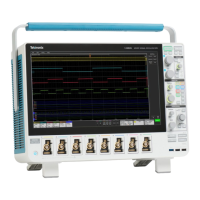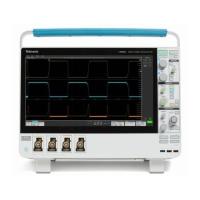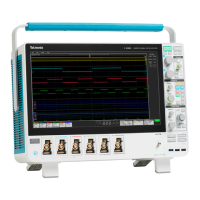Setting waveform display parameters
Use waveform display controls to set the display mode, persistence, style, and intensity display parameters, and graticule style
and intensity.
Use the following topics for more information on setting display parameters.
■
Set waveform display mode (Stacked or Overlay) on page 129
■
Set the Waveform Interpolation mode on page 129
■
Set the waveform persistence, style, and intensity on page 130
■
Set the graticule style and intensity on page 130
Set waveform display mode (Stacked or Overlay)
Use this procedure to change the waveform display mode (Stacked or Overlay).
1. Double-tap on an open graticule area to open the Waveform View configuration menu.
2. Tap the Display Mode buttons to toggle between Overlay and Stacked modes.
In stacked display mode, each waveform is stacked vertically in separate graticule slices. This is the default display mode.
In overlay display mode, all waveforms are displayed in a single graticule (traditional waveform view).
Set the Waveform Interpolation mode
Use this procedure to set the waveform interpolation mode, which sets how waveform data points are calculated between record
data points.
1. Double-tap on an open graticule area to open the Waveform View configuration menu.
2. Tap the buttons under Interpolation to select either Sin(x)/x or Linear.
Sin(x)/x calculates record points along a curve between the actual acquired samples. This form of interpolation is useful
when acquiring rounded waveforms such as sine waves. It is good for general-purpose uses but may introduce overshoot or
undershoot in signals with fast rise times. This interpolation is also useful for looking at high-frequency signals, especially
where the frequency components are just below the Nyquist frequency.
Linear calculates record points between actual acquired samples using a straight-line fit. This interpolation is useful for
measuring waveforms with fast rise times, such as pulse trains.
MSO54, MSO56, MSO58, MSO58LP, MSO64 Help 129

